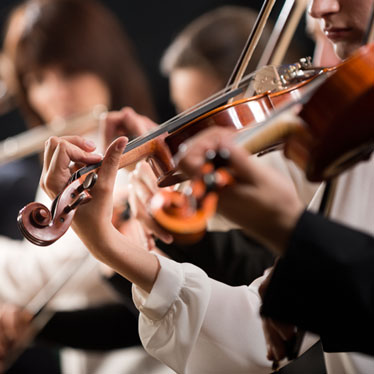What Instruments Are In The Orchestral String Family?

The orchestra is an amazing, musical body - comprised of a multitude of individual players and instruments - all working together to produce beautiful and harmonious sounds.
The string family of instruments are the largest "organ" in this body, and without them the overall sound orchestras produce would be and feel empty.
Orchestras Typically Boast Five Different Types of String Instruments
Most orchestras rely on five different types of string instruments to produce the majority of their works. However, the advent of modern and post-modern music - and the recent emphasis placed on world music genres - have shifted the classic, Orchestral 5 a bit.
However, let's begin with the five "classics."
Violins are the sopranos
There's no doubt that the soprano is "the star" of the orchestra. And, while every instrument has its place (and its share of concertos), the violin leads them all by a long-shot in terms of the amount of notes played per year!
It is considered the baby of the strings family - due to its smaller stature (24-inches) and higher voicing. There are more violins in the orchestra than any other instrument - with the largest of the world's famous orchestras having as many as 30 or more in their employ. Within that group, there are usual two sections; first and second. First violins play melody, while second violin parts alternate between melody and harmony.
Violas are the altos
Serving as the alto voice in the orchestra, and shaped like a violin, the viola's deeper voicing comes from its slightly larger body - wider than a violin and just over two-feet long. Violas produce a warmer and richer sound, and as such there are usually only 10 to 14 violists in an orchestra.
Violas almost always play harmony, but there are many beautiful viola solos that are well-beloved because of the warm, honeyed tones produced by their players. Like the violin, the viola is played with it's body held between the chin and shoulder, the left hand fingering notes on four strings stretched up the neck, while the right hand bows the strings artfully.
Cellos form the tenor section
While shaped like the violin and viola, the cello's 4-foot+ stature makes it impossible to play tucked between the chin and neck. Thus, this instrument - said to be the most similar in tone to the human voice - is played while seated, the body resting between the legs and its neck resting alongside the left shoulder and neck of the musician.
Orchestras typically have between eight- and 12 cellists, and they play both melody and harmony. Most often, you'll find them playing a deeper and rich, harmonic accompaniment to the violins. However, with pieces like Bach's Cello Suites ranking in top classical music downloads, cellos are also popular solo instruments.
The Double Bass lives up to its name
As we decrease in sound vibration (moving lower) we increase in size - which brings us to the double base. Standing (literally) over six-feet long, the double bass is played standing up (or sitting on a stool). Classical music finds the upright bass mostly bowed, although other genres of music take advantage of the bass's percussion-like plucks and slaps.
Double Bass parts are played a solid octave below the cellos, forming a deeply rooted foundation for the rest of the orchestra to lean on.
The Harp is a celestial addition
Finally, while not an orchestral regular, there is the harp. Shaped like a number-7, the harp has 47-strings that are tuned to the white keys on a piano. Pedals at the foot of the harp allow players to shift the length of the strings, to play the "black key" notes.
Harps are about six-feet tall and harpists sit, playing perpendicular to their body, using the tips of their fingers and thumbs. While harps aren't written into the majority of orchestral pieces, audiences appreciate when they are due to their soothing and celestial sound.
Lesser-Thought About Orchestral String Instruments
As we mentioned above, modern- and post-modern music as well as an appreciation for music around the world, mean some string instrument cousins are making their way into orchestra payrolls.
Examples include the guitar, which have been included in orchestral compositions for more than 500-years, as well as other string instruments you may not know about, like the erhu, nyckelharpa, psaltery, the domra and balalaika and others.
Each member of the orchestral string family adds its own personality and voice to the body of music the orchestra produces. Variety in compositions, musical dynamics, and the vision of orchestra conductors ensure each one has the chance to shine over the course of an orchestra's annual performance calendar.
Just for fun, we recommend taking our quiz, Which String Instrument Are You?, which could help you discover which orchestral string instrument you should take up next.


